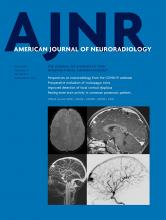We read with great interest the article by Yu et al,1 which investigated the utility of myelin volume fraction, axon volume fraction, and G-ratio, which is the ratio of the inner-to-outer diameter of a nerve fiber, in the evaluation of WM in patients with MS. They used macromolecular tissue volume imaging to calculate myelin volume fraction and revealed that myelin volume fraction was lower in the normal-appearing WM of patients with MS compared with the WM of healthy controls. Furthermore, they also revealed that disability, as measured by the Expanded Disability Status Scale, was significantly associated with myelin volume fraction in the normal-appearing WM of patients with MS. We believe that this study is an important step toward the introduction of myelin imaging into clinical practice.
We thank Yu et al1 for referring to our article entitled, “Analysis of White Matter Damage in Patients with Multiple Sclerosis via a Novel In Vivo MR Method for Measuring Myelin, Axons, and G-Ratio.”2 The myelin volume fraction used in our study was calculated from the R1 and R2 relaxation rates and proton density measured by synthetic MR imaging, by simulating a 4-compartment model: myelin volume fraction, cellular volume fraction, excess parenchymal water volume fraction, and free water volume fraction.3 Myelin volume fraction in the MS lesions in our study was lower than in their study, and they discussed this discrepancy possibly being because the 4-compartment model used in our study did not incorporate the partial volume pool to account for magnetization transfer effects. Even though magnetization transfer effects may have resulted in small changes in the measured R2 estimations, myelin is estimated from combinations of the measured R1, R2, and proton density values by the model used in our study, and the effect of a potential offset in R2 is expected to be small.
Here, we should also consider the fact that magnetization transfer imaging, which detects macromolecules, is known to be sensitive to not only intact myelin but also other macromolecules, including myelin debris.4 Hence, macromolecular tissue volume may also be affected by myelin debris, which may have led to the higher myelin volume fraction in the study by Yu et al1 than in our study. Because myelin debris is assumed to have much lower R2 than the tightly packed myelin, the contribution of myelin debris to the estimated myelin by synthetic MR imaging is expected to be small. Because myelin imaging can be affected by a number of factors, the interpretation of the results is not straightforward. A histologic study comparing macromolecular tissue volume and synthetic myelin imaging is awaited to further disentangle the mechanism underlying the discrepancy in the results between the study by Yu et al1 and our study.
Footnotes
This work was supported by Japan Society for the Promotion of Science KAKENHI grant No. 16K19852 and grant No. JP16H06280, Grant-in-Aid for Scientific Research on Innovative Areas-Resource and technical support platforms for promoting research “Advanced Bioimaging Support.” This work was also supported by the program for Brain Mapping by Integrated Neurotechnologies for Disease Studies (Brain/MINDS) from the Japan Agency for Medical Research and Development, AMED.
Disclosures: Akifumi Hagiwara—RELATED: Grant: Japan Society for the Promotion of Science KAKENHI, Grant-in-Aid for Scientific Research on Innovative Areas-Resource and technical support platforms for promoting research “Advanced Bioimaging Support,” and Japan Agency for Medical Research and Development, Comments: Japan Society for the Promotion of Science KAKENHI grant No. 16K19852, grant No. JP16H06280, Grant-in-Aid for Scientific Research on Innovative Areas-Resource and technical support platforms for promoting research “Advanced Bioimaging Support,” the program for Brain Mapping by Integrated Neurotechnologies for Disease Studies from Japan Agency for Medical Research and Development. Osamu Abe—UNRELATED: Grants/Grants Pending: Canon Medical Systems, Daiichi Sankyo Company Ltd, Eisai Co Ltd, Bayer Yakuhin Ltd, Nihon Medi-Physics Co Ltd, Fujifilm, Toyama Chemical Co Ltd, Guerbet Japan, Siemens Healthcare Diagnostics KK, and Fuji Pharma Co Ltd*; Payment for Lectures Including Service on Speakers Bureaus: Canon Medical Systems, Daiichi Sankyo Company Ltd, Eisai Co Ltd, Bayer Yakuhin Ltd, GE Healthcare, Hitachi HealthCare, Philips Healthcare, Fujifilm, Toyama Chemical Co Ltd, Guerbet Japan, Nippon Zoki Pharmaceuticals Co Ltd, AZE, Siemens Healthcare Diagnostics KK, and Fuji Pharma Co Ltd. Shigeki Aoki—RELATED: Grant: Japan Society for the Promotion of Science KAKENHI 18H02772, “Advanced Bioimaging Support,” Comments: Japan Society for the Promotion of Science KAKENHI grant No.18H02772, Grant-in-Aid for Scientific Research on Innovative Areas-Resource and technical support platforms for promoting research “Advanced Bioimaging Support”*; UNRELATED: Board Membership: Bayer Yakuhin Ltd, Canon Medical Systems; Grants/Grants Pending: Bayer Yakuhin Ltd, Daiichi Sankyo Co Ltd, Eisai, Fuji-Toyamakagaku, Nihon Medi-Physics Co Ltd, Guerbet Japan; Payment for Lectures Including Service on Speakers Bureaus: GE Healthcare, Canon Medical Systems, AZE, Siemens Healthineers, Bayer Yakuhin Ltd, Daiichi Sankyo Co Ltd, Eisai, Fuji-Toyamakagaku, Mediphysics, Guerbet Japan. *Money paid to the institution.
Indicates open access to non-subscribers at www.ajnr.org
- © 2020 by American Journal of Neuroradiology







